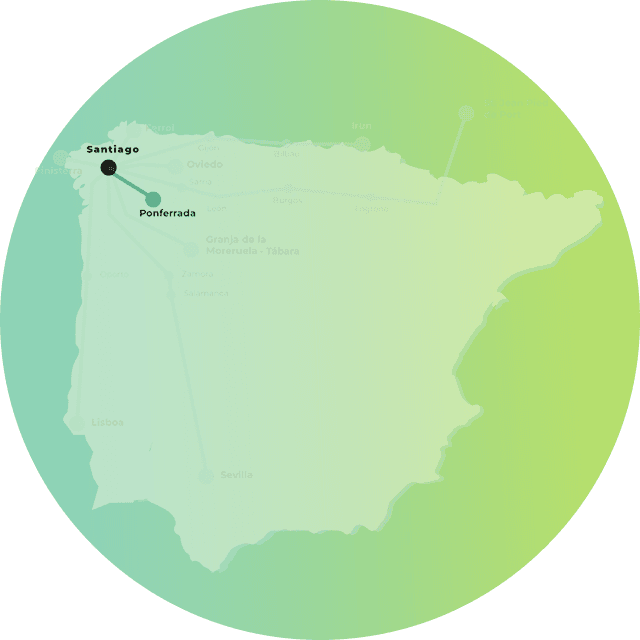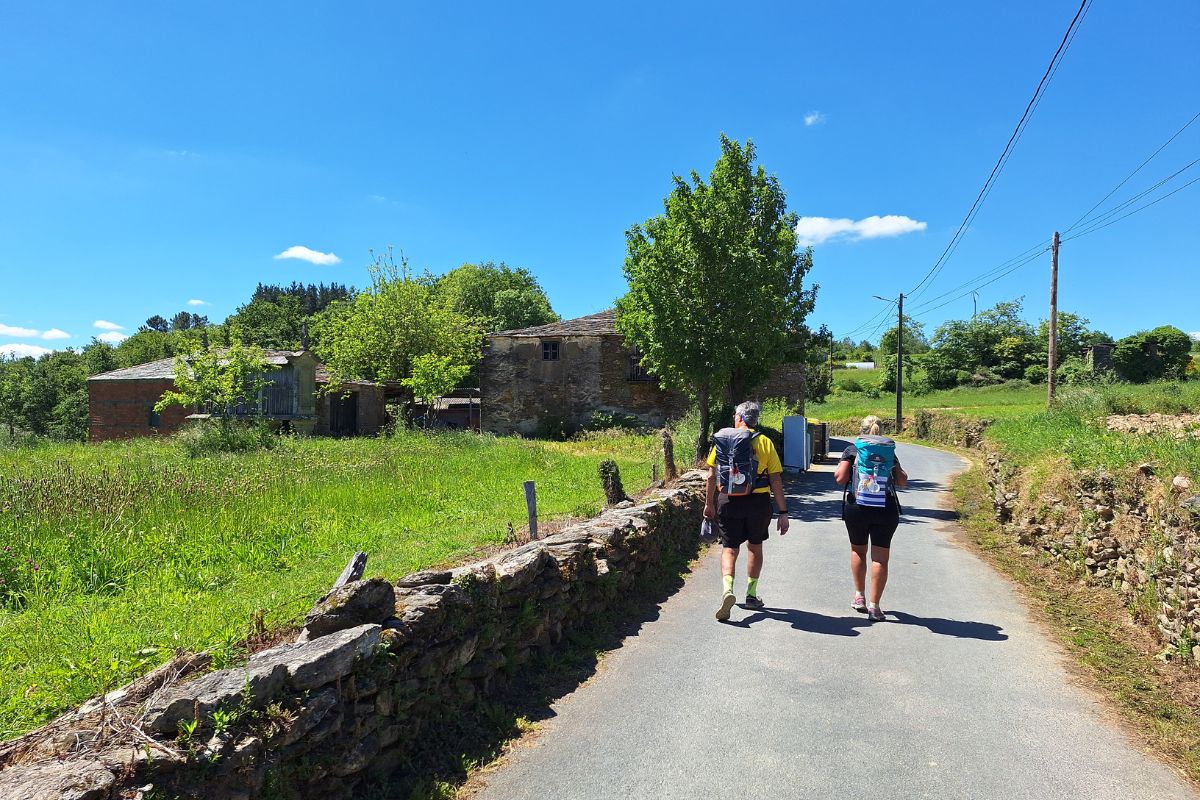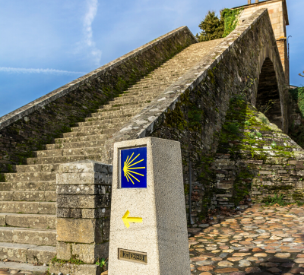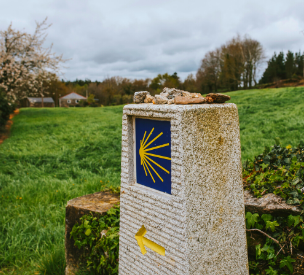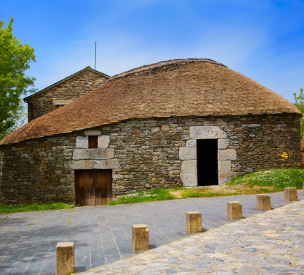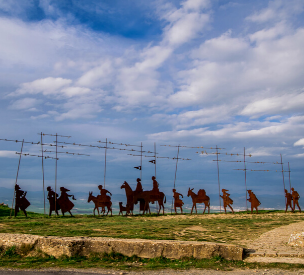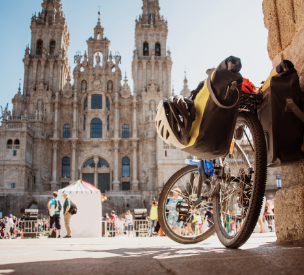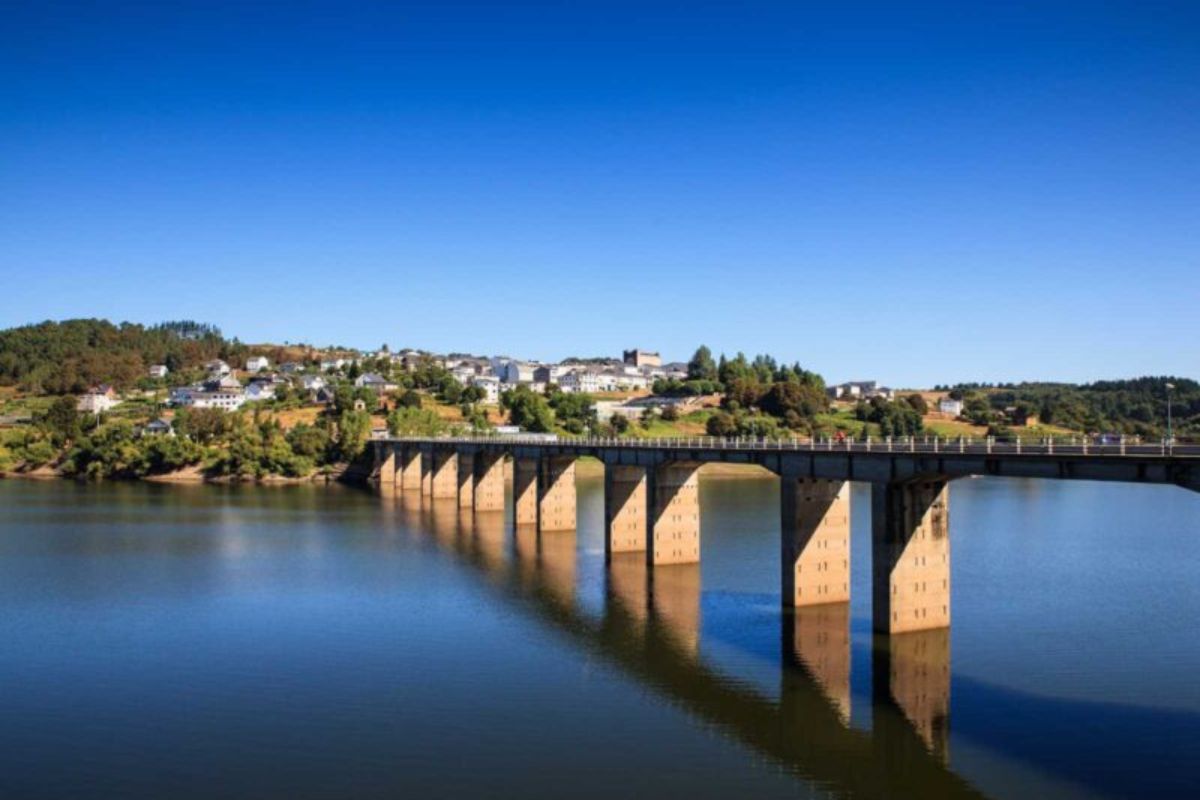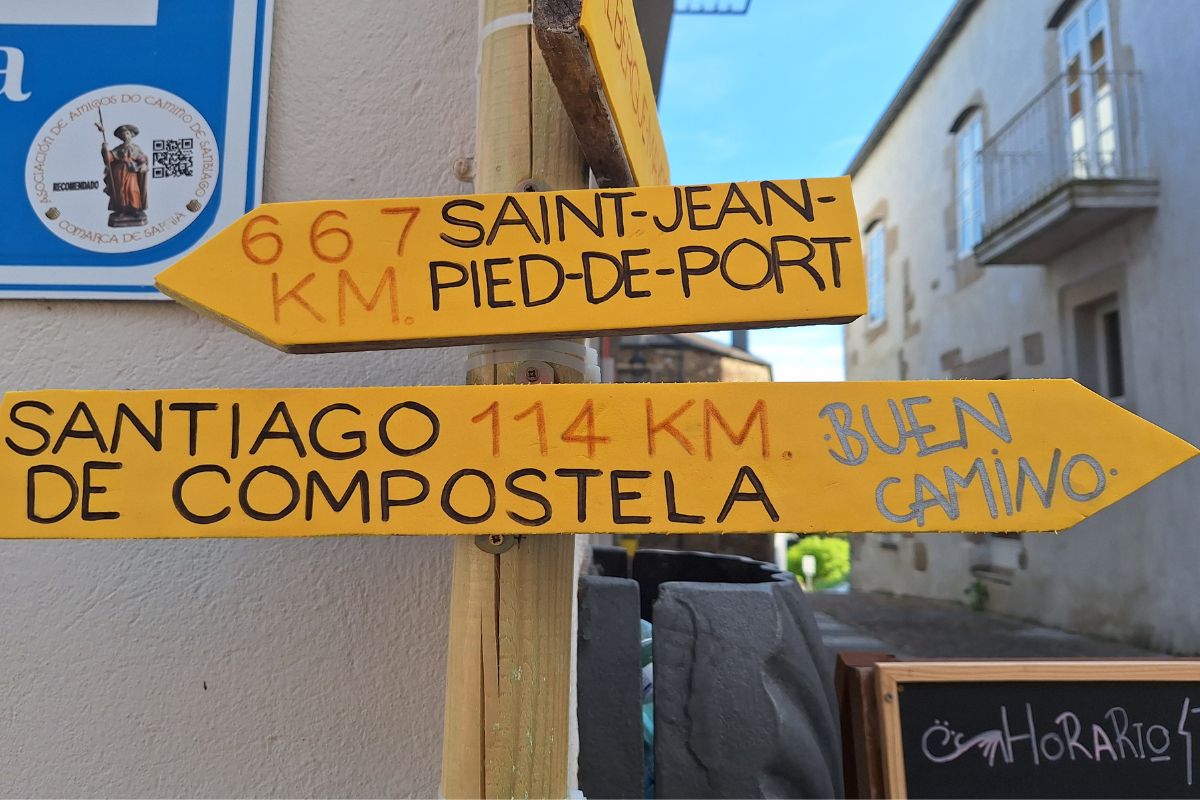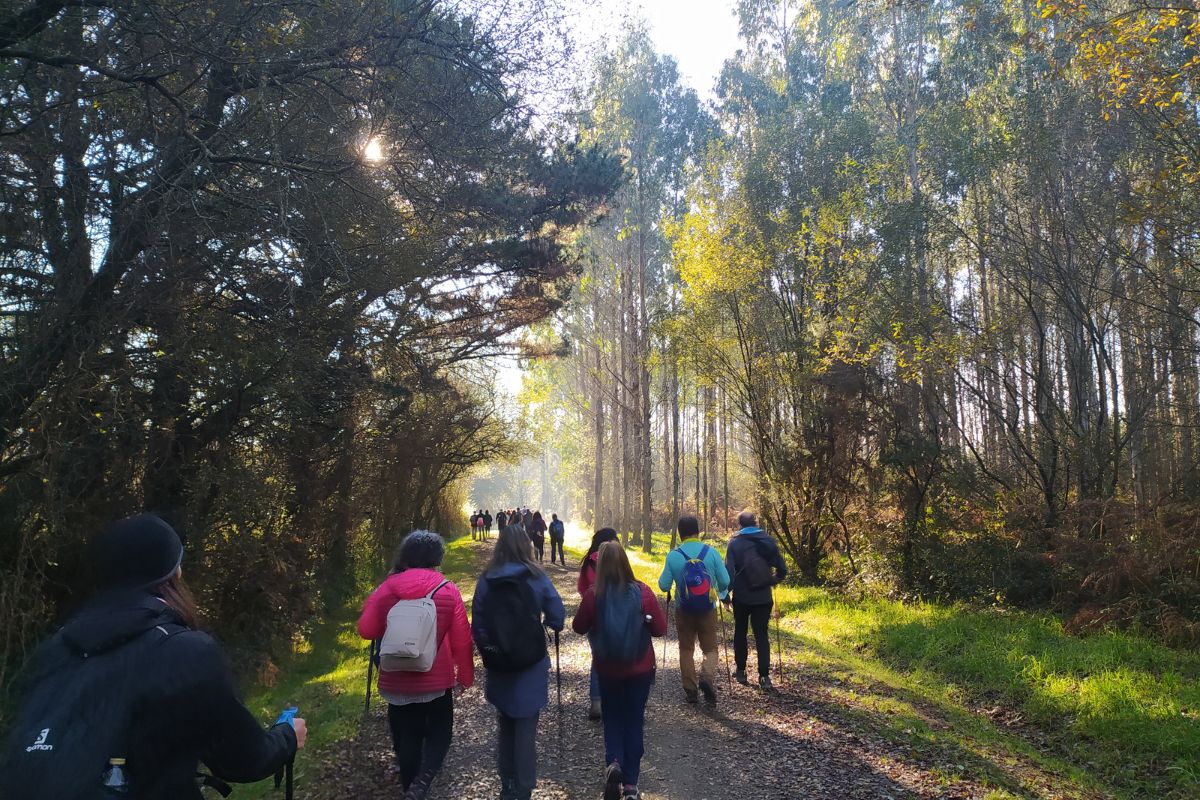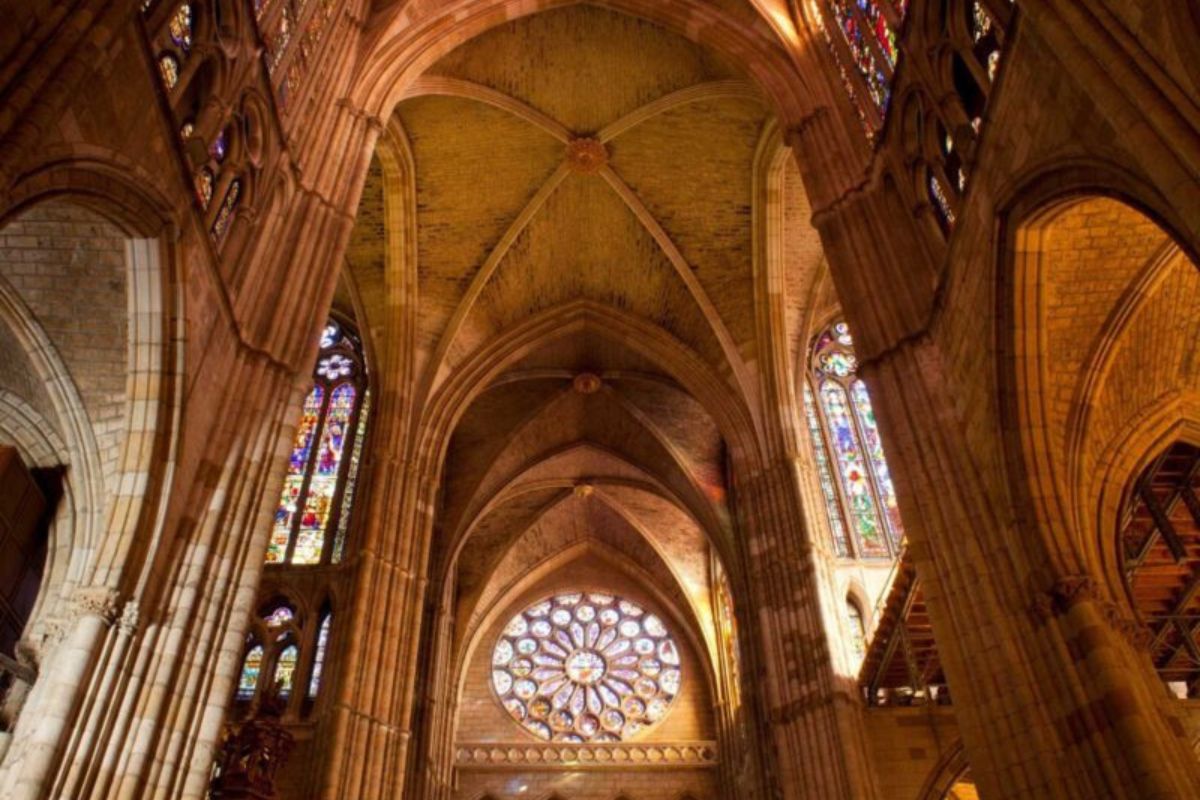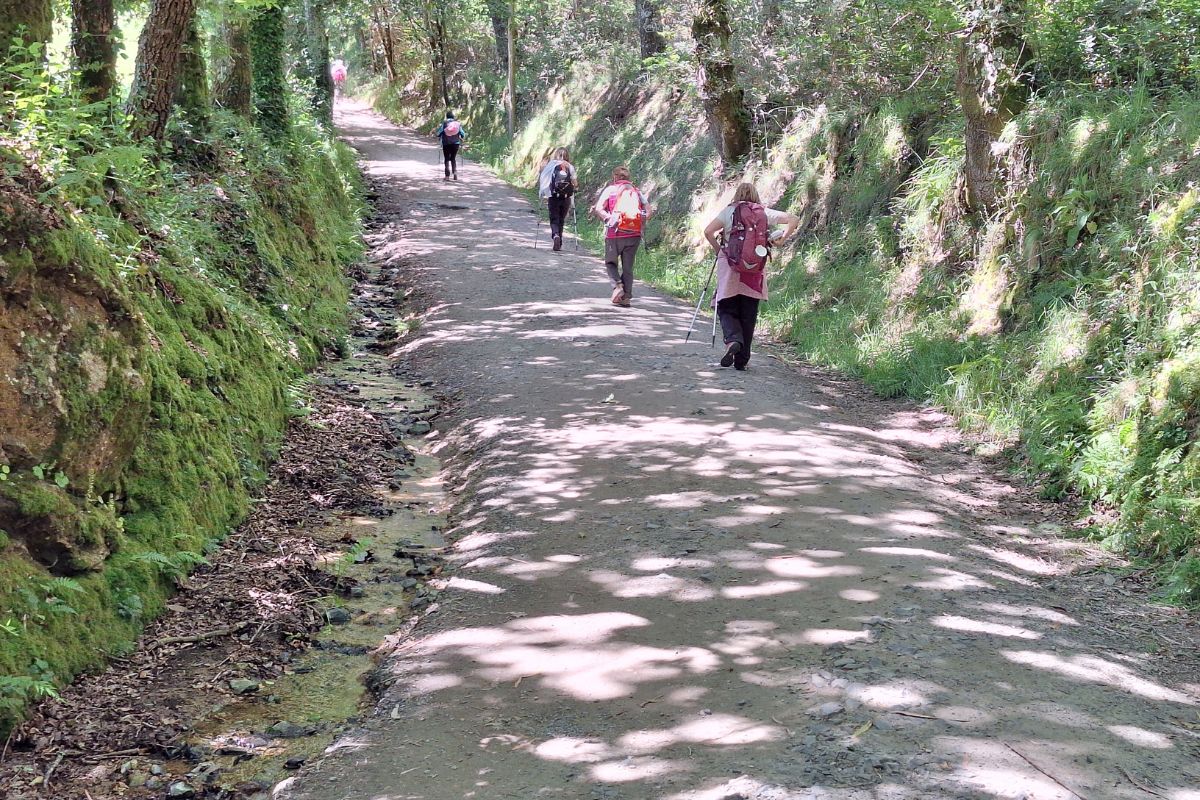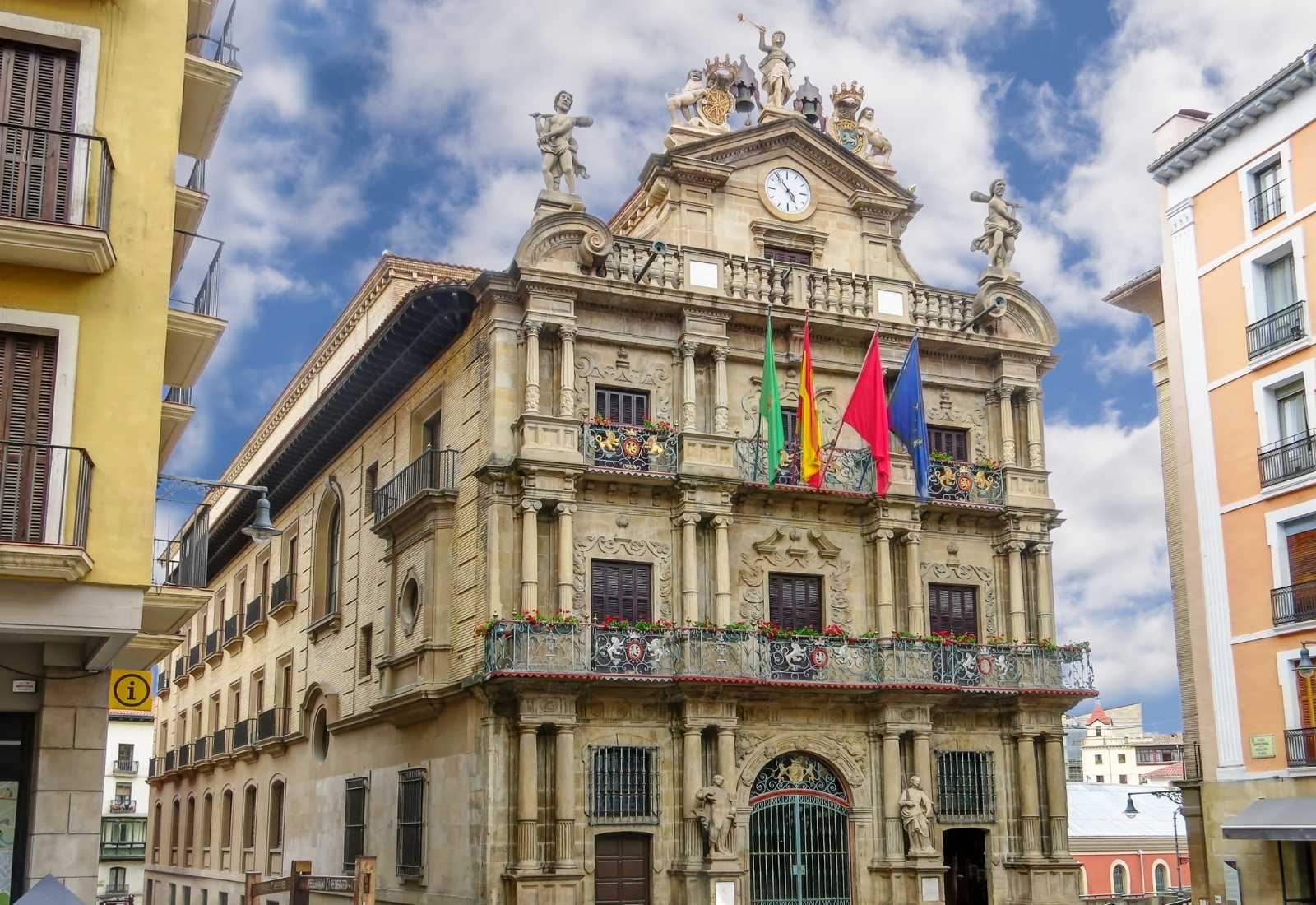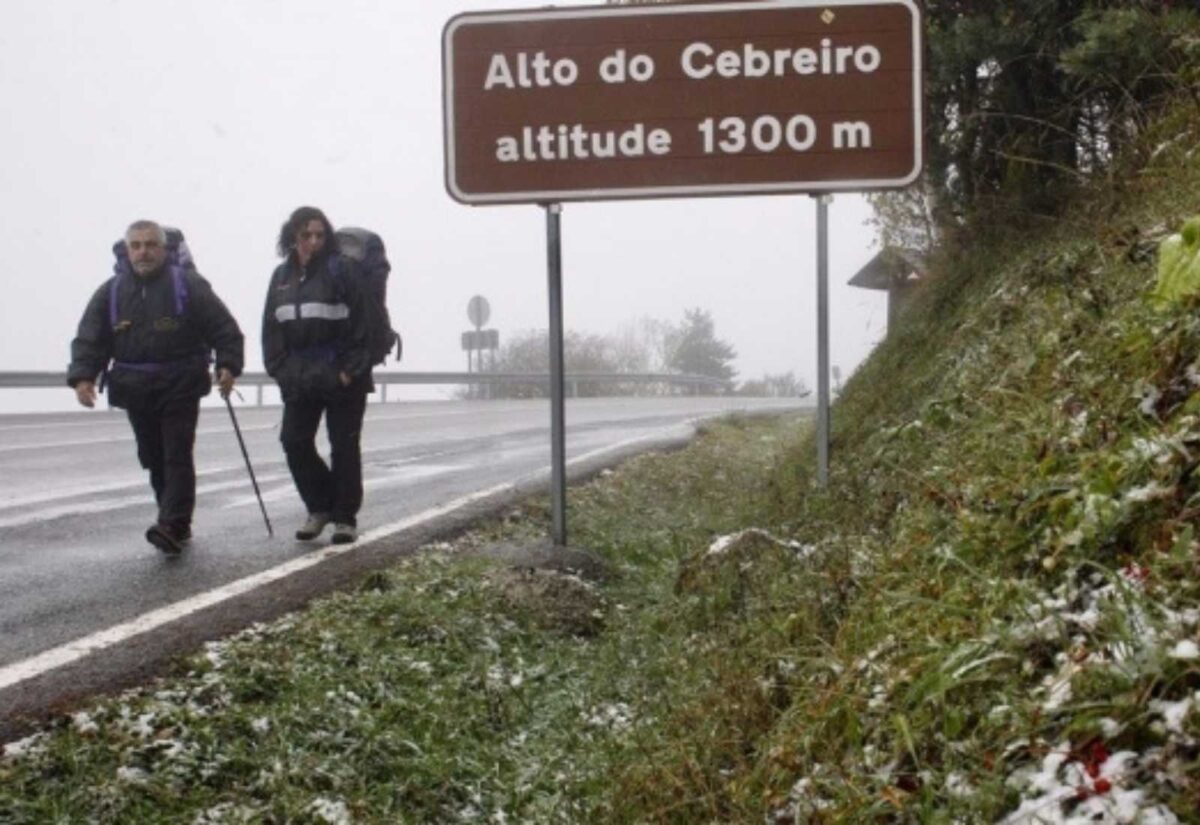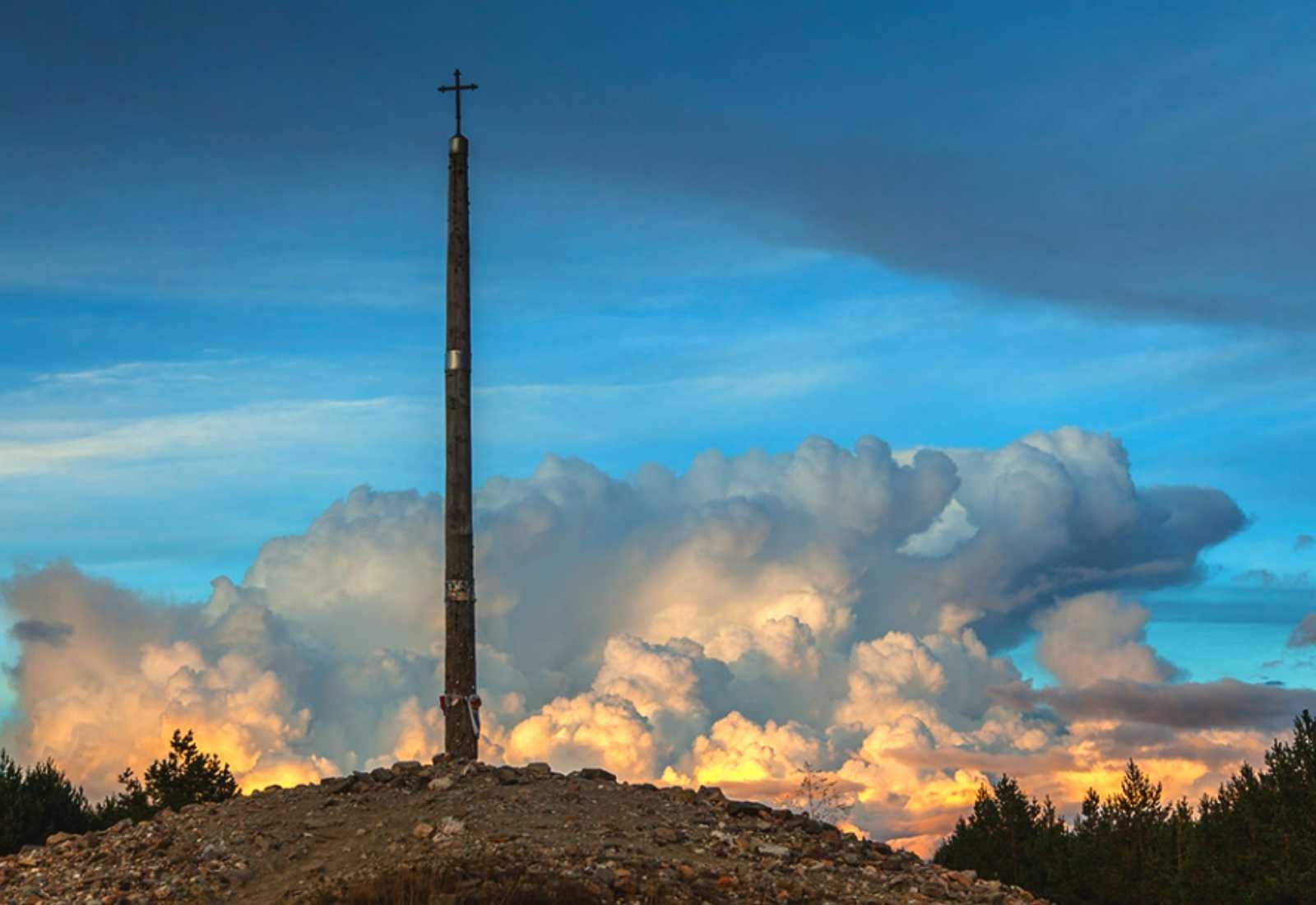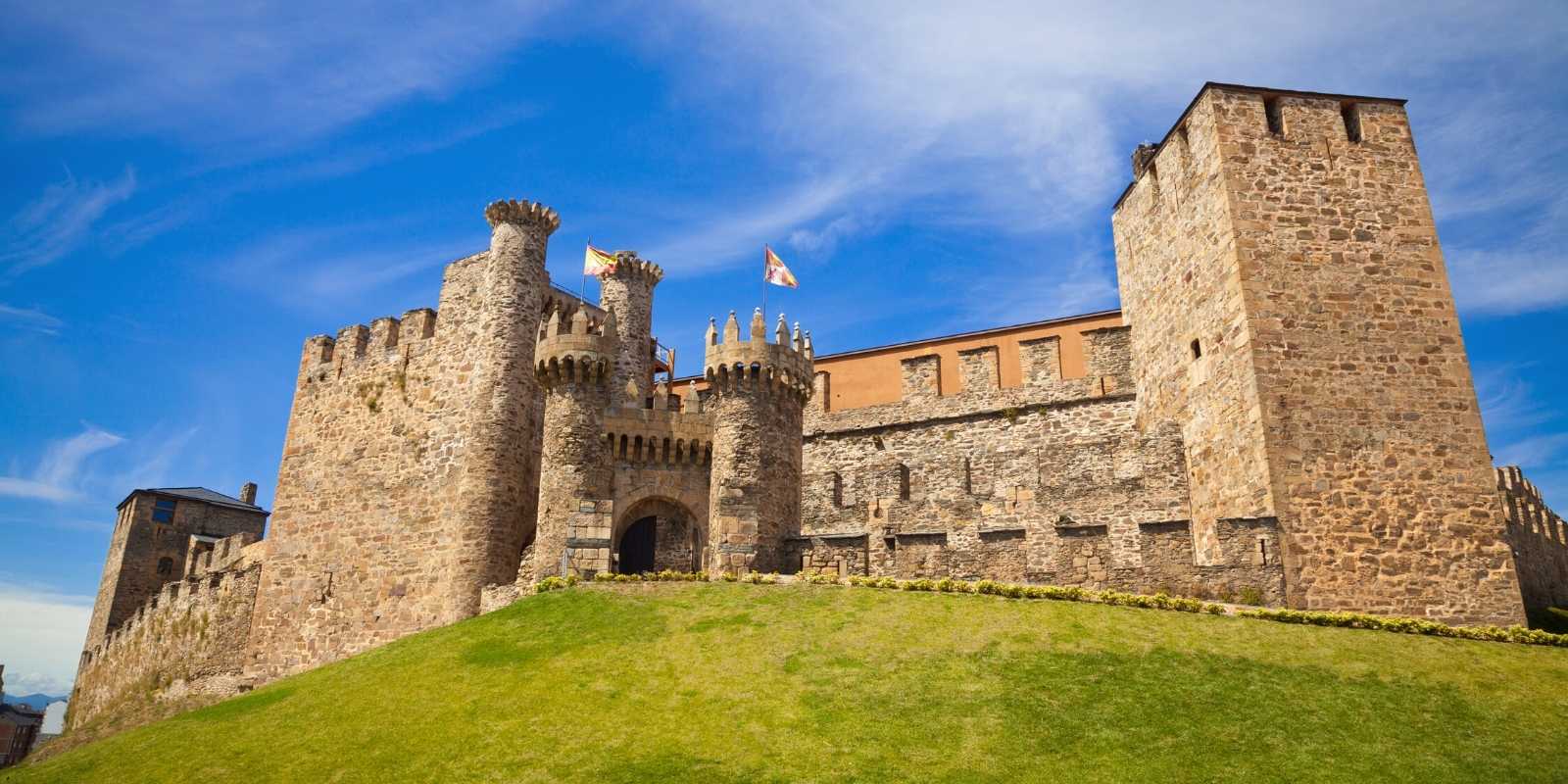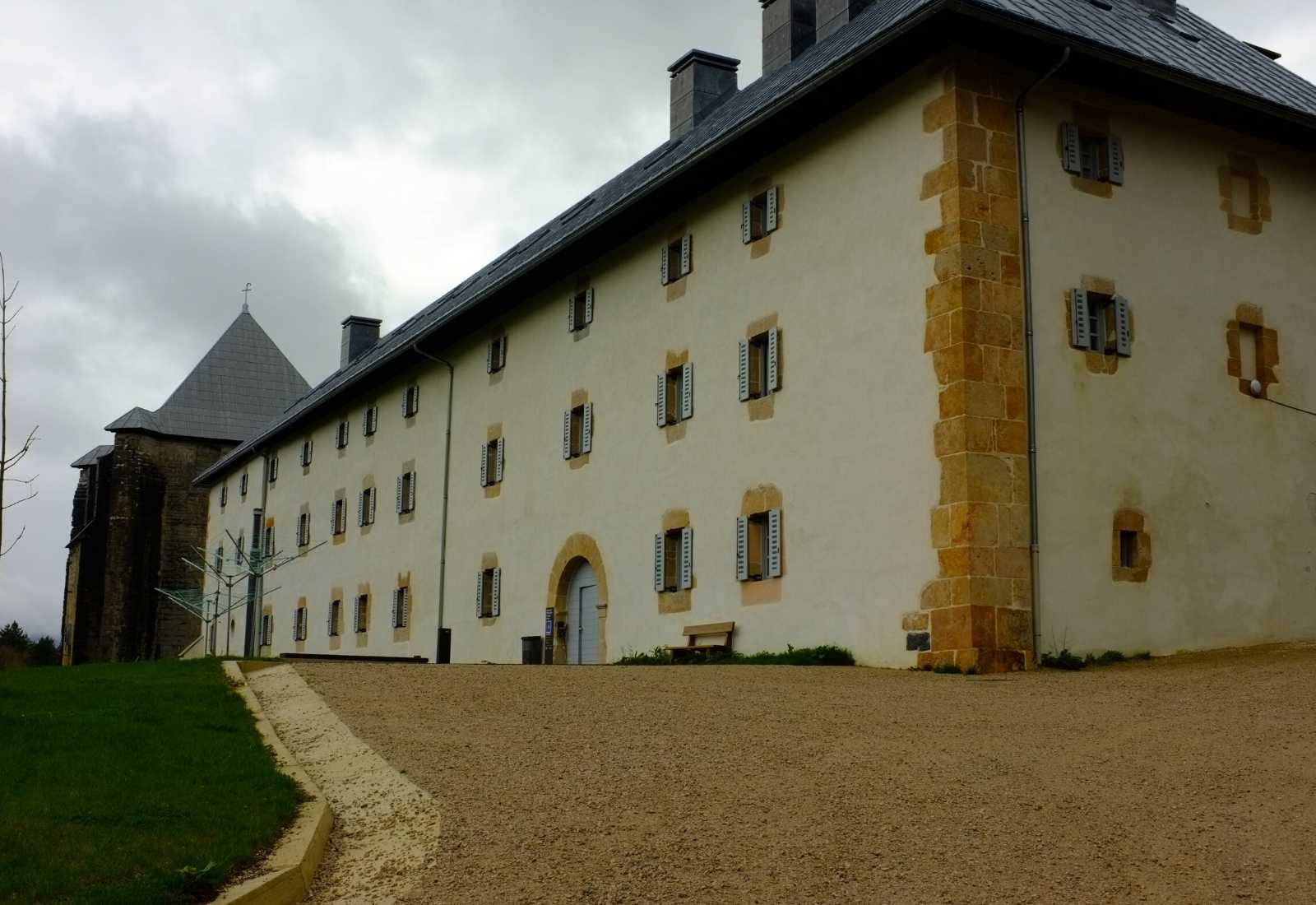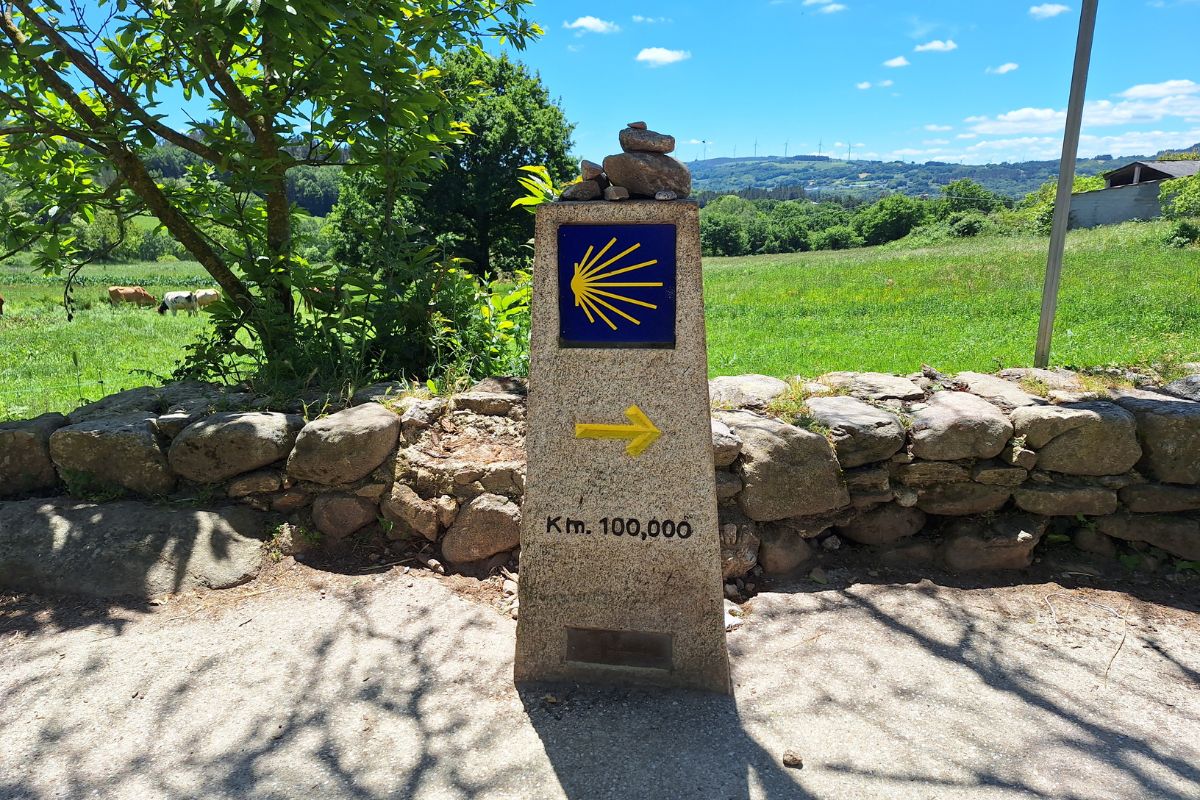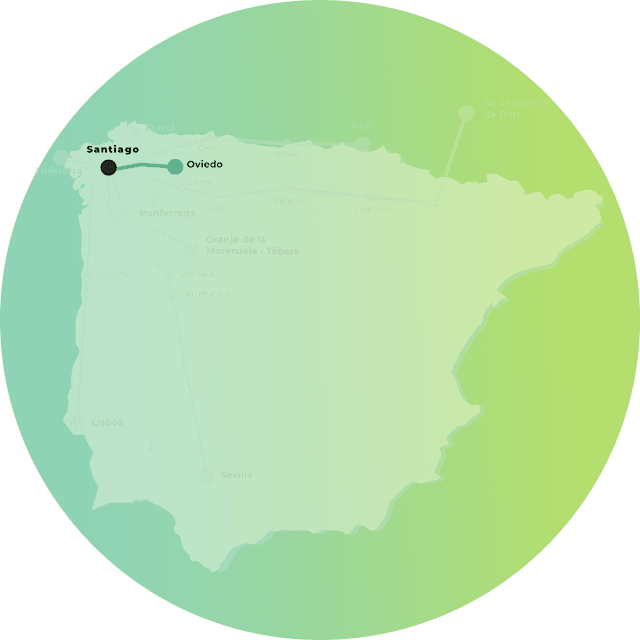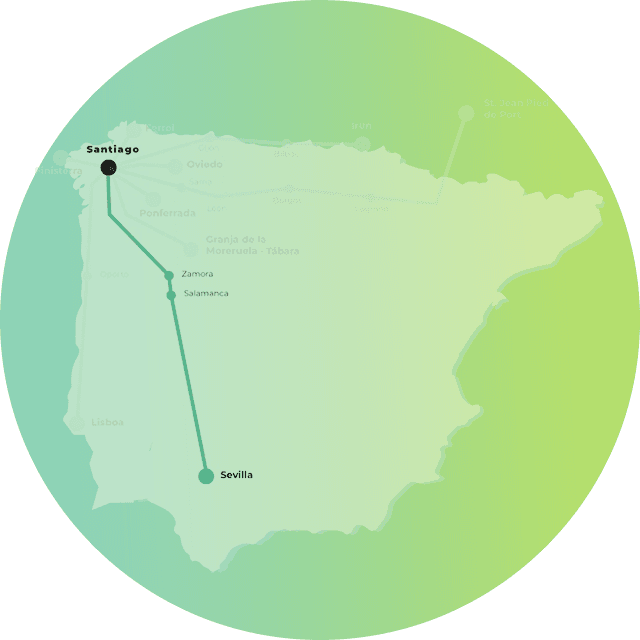The French Way
The iconic route of the Camino de Santiago.
This is the most internationally renowned and historically significant route of the Camino de Santiago, where most medieval pilgrimage paths converge.
The French Way of the Camino de Santiago is a major social, cultural, and religious phenomenon that has, over the centuries, welcomed great kings, princesses, nobles, Templars, knights, the poor, and the faithful from all across Christendom, all coming to kneel before the tomb of the Apostle James.
Services we offer on the French Way of Saint James
Included in all our routes
- Accommodation booking selecting the best lodgings according to your budget.
- Luggage transport between stages.
- Practical information about the Camino in a detailed guide.
- Phone assistance en route we’re by your side for any questions or incidents.
- Travel insurance with broad coverage.
On group tours
- Accompanying guides professional support throughout the Camino.
- Support vehicle available during the stages.
Optional services
- Meals and diets: option to add breakfasts or half board.
- Private transfers to/from the point you need.
- Bicycle rental (mountain or electric bikes).
Map of French Way
The map displays the complete route of the French Way of the Camino de Santiago, from Saint-Jean-Pied-de-Port in France to Santiago de Compostela in Galicia, Spain. This historic pilgrimage route, spanning approximately 800 km, passes through major cities and towns such as Pamplona, Logroño, Burgos, León, and Sarria.
At the bottom, the elevation profile of the route is shown, highlighting the changes in altitude and mountainous sections, including the Pyrenees at the start, the Cruz de Ferro in the Montes de León, and the ascent to O Cebreiro in Galicia. Each stage offers a unique experience, with ever-changing landscapes and a rich cultural heritage, making it an unforgettable spiritual and physical journey.
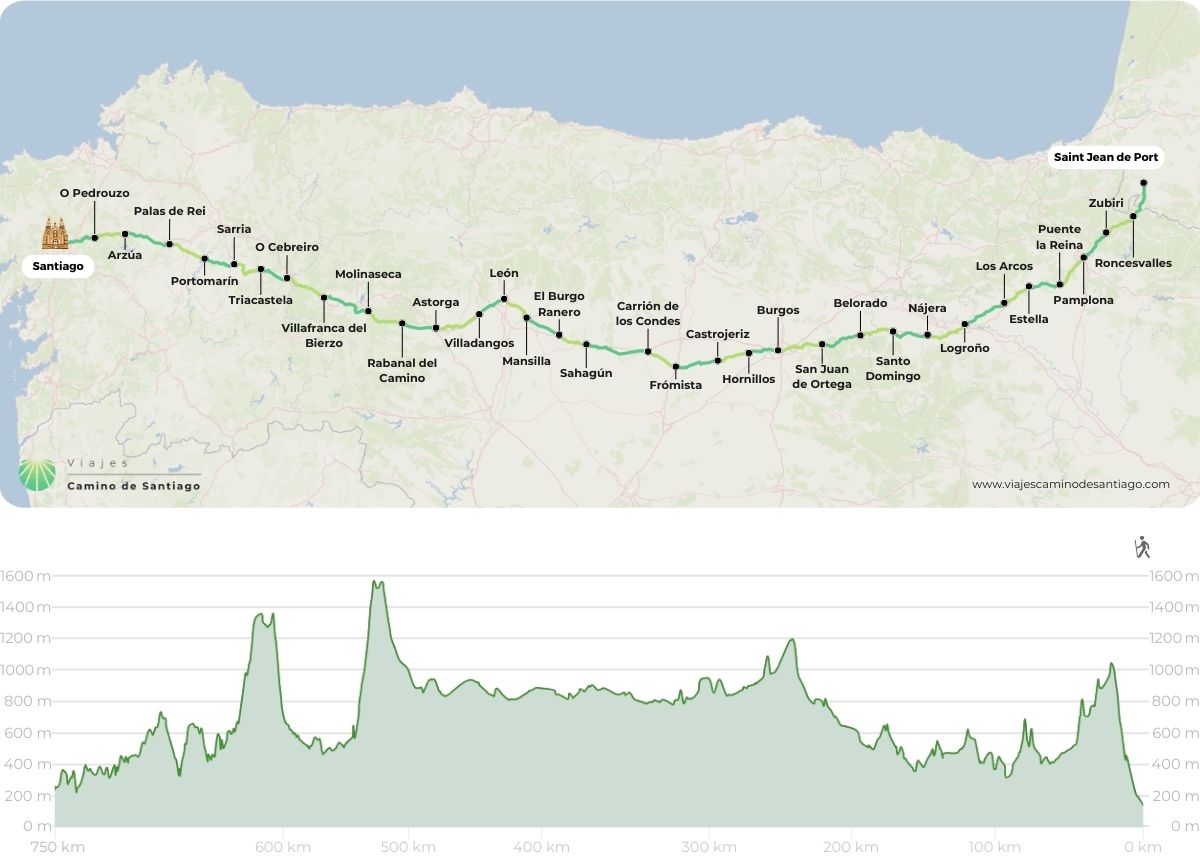
Information about the French Way
Why choose the French Way?
The French Way is the most popular route of the Camino de Santiago.
If you choose to walk the French Way, you will experience the lush green mountains of Navarre, the Rioja vineyards, the vast seas of wheat fields in the Castilian plateau, and the verdant Bierzo Valley, before immersing yourself in the most authentic and rural Galicia, all the way to Santiago de Compostela.
This route will also give you the chance to visit breathtaking monuments, castles, and bridges, as well as historic Jacobean cities, forever marked by the spirit of pilgrimage.
What to see and do on the French Way?
There is a lot to see on the French Way of the Camino de Santiago.
Where to start the French Way?
From Saint Jean Pied de Port or Roncesvalles
Today, both Saint Jean Pied de Port and Roncesvalles can be considered starting points for the Camino Francés, so either option is perfect if you want to do the entire route.
Saint Jean Pied de Port, located on the border with France, is the second most popular starting point for pilgrims. It’s worth adding an extra day to your journey to enjoy the spectacular Pyrenees landscape and cross the border following in the footsteps of none other than Napoleon Bonaparte. The main challenge of this first stage lies in the elevation changes, as you’ll accumulate no less than 1,258 meters of positive elevation and 485 meters of negative elevation, so a good level of physical fitness is required, or you can take the variant through Valcarlos.
In Spain, just 24 kilometers from Saint Jean Pied de Port, you’ll find the small town of Roncesvalles (Orreaga). It’s one of the major landmarks of the Camino de Santiago and the most commonly used starting point for pilgrims walking the full Camino Francés from Roncesvalles. A magical town where time seems to have stood still, it preserves the spirit of the pilgrimage and a deep magnetism. You can also take your bike and do the Camino Francés by bike from Roncesvalles.
You might be interested: How to get to Roncesvalles?
From Logroño
From Logroño to Santiago de Compostela, you’ll cover a distance of just over 600 kilometers, which will take you around 27 days. The stages of the Camino Francés from the capital of La Rioja are marked by plains surrounded by farmland and renowned vineyards. There’s a notable change in the landscape as you reach the Montes de Oca, near Burgos. The most common way to walk the Camino Francés from Logroño to Burgos is in 5 stages.
From Burgos
From Burgos, you’ll walk for 22 days, covering a total of 488 kilometers to reach Santiago de Compostela. This is one of the most authentic sections, still retaining the purest essence of the Jacobean route. A path for reflection, inviting you to lose yourself in the vast plains of cereal fields and the solitary landscapes of the Castilian steppe. The most common way to walk the Camino Francés from Burgos to León is in 8 stages.
From León
León is the perfect city to start the Camino Francés if you have 15 days, during which you’ll cover 308 kilometers. A fascinating journey where you’ll pass through beautiful landscapes like the Montes de León and the green Bierzo Valley. With every step, you’ll discover small medieval villages, Templar castles, imposing monuments, and cathedrals, until you reach the most authentic rural Galicia. If you only have a week and want to start from this point, it’s recommended to do the Camino Francés from León to O Cebreiro in 6 stages, or to bike the Camino Francés from Ponferrada or from León.
From O Cebreiro
This small and unique village, located on the border between Galicia and Castilla y León, is one of the favorite spots for pilgrims to start the Camino Francés from O Cebreiro. From here, you can fully walk the Galician section of this Jacobean route in just 9 days, covering a total of 150 kilometers to reach the Cathedral of Santiago.
The stages are characterized by shaded paths that wind through centuries-old forests, small villages, and lush meadows, showcasing the unique culture and identity of the people in this Autonomous Community.
You might be interested: How to get to O Cebreiro?
From Sarria
The town of Sarria is the most popular starting point for pilgrims who wish to walk the final section of the Camino Francés, the Camino de Santiago from Sarria. From here, you’ll cover the last 100 kilometers of the Camino Francés, the minimum distance required to receive the Compostela. You’ll need just one week to complete it.
Sarria is both loved and hated in equal measure, as the number of pilgrims increases significantly during the summer months. You’ll find all kinds of services, accommodations, laundromats, bars, restaurants, as well as shops and souvenir stores. In short, the atmosphere you’ll encounter in these stages is much livelier than anywhere else along the Camino Francés.
This is the perfect route for those walking the Camino de Santiago for the first time. It’s ideal for meeting new people and enjoying the beautiful landscapes of rural Galicia. And if you don’t have anyone to travel with, walking in a group from Sarria is your ideal trip.
You might be interested: How to get to Sarria?
Stages of the French Way
The Camino de Santiago Francés is the most iconic and well-traveled Jacobean route, filled with history, spirituality, and natural beauty. Spanning approximately 800 kilometers, from Saint-Jean-Pied-de-Port to Santiago de Compostela, it takes you through various stages that pass through stunning landscapes, charming villages, and monuments rich in meaning. Each section offers a unique experience, from the Pyrenees to the Castilian plateau and the green valleys of Galicia. Through these links, you will discover the main stages, their distances, points of interest, and helpful tips to fully enjoy this unforgettable adventure.
The villages along the French Way of the Camino de Santiago
-
Hornillos del Camino
-
Hospital de Órbigo
-
Irache
-
Larrasoaña
-
Lavacolla
-
Ledigos
-
León
-
Logroño
-
Mansilla de las Mulas
-
Melide
-
Molinaseca
-
Monte do Gozo
-
Muruzábal
-
Nájera
-
Navarrete
-
O Pedrouzo
-
Obanos
-
Palas de Rei
-
Pamplona
-
Ponferrada
-
Portomarín
-
Puente la Reina
-
Rabanal del Camino
-
Rabé de las Calzadas
-
Redecilla del Camino
-
Reliegos
-
Ribadiso
-
Roncesvalles
-
Sahagún
-
Saint Jean Pied de Port
-
Samos
-
San Juan de Ortega
-
San Millán de la Cogolla
-
Santa Irene
-
Santo Domingo de la Calzada
-
Sarria
-
Tardajos
-
Terradillos de los Templarios
-
Tierra de Campos
-
Torres del Río
-
Triacastela
-
Valcarlos
-
Vega de Valcarce
-
Viana
-
Villadangos del Páramo
-
Villafranca del Bierzo
-
Villafranca de Montes de Oca
-
Villamayor de Monjardín
-
Viloria de Rioja
-
Zubiri
History of the French Way
Let’s take a brief look at the history of the Camino de Santiago and set the context.
Origin of the Camino de Santiago
We go back to the years 41 and 44 AD. After the death of the Apostle James, his remains were transported by boat from Jerusalem to Iria Flavia in Galicia. This event is known as the Traslatio. Much later, in the year 812, an incredibly important discovery was made: the tomb of the Apostle.
The main pilgrimage route of medieval Europe
The news spread like wildfire across Europe: the remains of the Apostle rested in a place called Compostela, an event that became a symbol of Christianity in contrast to the Muslim occupation of the time. During the 11th century, the influx of pilgrims increased, and kings began organizing efforts to facilitate the movement and safety of the travelers.
In the 12th century, the Codex Calixtinus was written, a true medieval guide to the pilgrimage to Santiago. It describes the Camino Francés from the Pyrenees to Santiago de Compostela and informs pilgrims of the services they would find along the route: fountains, food, sanctuaries, hospitals, local customs, etc.
Era of Decline
In the last centuries of the Middle Ages, pilgrimages to Santiago de Compostela experienced a major decline. European wars, the Black Plague, and the Schism in the Christian world caused the number of pilgrims to decrease significantly. From the 16th century onwards, the number of pilgrims continued to drop until it nearly disappeared after the Mendizábal Disentailment, which led to the extinction of the hospitality that had been offered up until then.
Revival
Starting in the mid-20th century, various initiatives began to emerge to recover the Camino from obscurity. Thanks to renewed interest from local governments, Pope John Paul II’s visits to Santiago in the 1980s, the formation of multiple associations and brotherhoods, and the declaration of the Camino as a UNESCO World Heritage Site in 1987, the Camino de Santiago rose from its decline to become the most important pilgrimage in the Western world. We must also remember the role of one of the great promoters of the modern revival of the French route, the parish priest of O Cebreiro, Elías Valiña, creator of the famous yellow arrow that now guides pilgrims.
Frequently asked questions about the French Way
The French Way of Santiago passes through a series of towns and cities rich in history, culture, and unique landscapes. Some of the most important towns and cities along the French Way are:
- Saint-Jean-Pied-de-Port (France): The starting point of the French Camino, this picturesque town at the foot of the Pyrenees is known for its cobbled streets and the impressive Santiago Gate.
- Roncesvalles: After crossing the Pyrenees, Roncesvalles marks the entry into Spain. Its collegiate church and historical significance make it a key spiritual stop for pilgrims.
- Pamplona: Famous for its San Fermín running of the bulls, Pamplona is a vibrant city with rich medieval heritage, highlighted by its cathedral and city walls.
- Logroño: The capital of La Rioja, known for its wines and delicious gastronomy. Logroño is an excellent place to enjoy tapas on the famous Laurel Street.
- Burgos: Burgos boasts one of the most impressive Gothic cathedrals in Spain, a UNESCO World Heritage Site. Its historic center is also a must-see on the Camino.
- Carrión de los Condes: This small town in the province of Palencia stands out for its rich medieval history and Romanesque churches, offering a more intimate experience on the Camino.
- León: With a majestic Gothic cathedral, the Convent of San Marcos, and vibrant urban life, León is one of the most important cities along the route, ideal for taking an extended break.
- Astorga: This city features the Episcopal Palace designed by Gaudí and a beautiful cathedral, serving as a crossroads between the French Camino and the Via de la Plata.
- Ponferrada: Famous for its Templar castle, Ponferrada is the gateway to the El Bierzo region and an important stop before tackling the mountains of Galicia.
- O Cebreiro: This charming mountain village is one of the most iconic stops on the Camino, known for its traditional palloza houses and its connection to the Holy Grail.
- Sarria: A starting point for many pilgrims who wish to complete the final 100 kilometers required to earn the Compostela. Sarria is an essential stop.
- Portomarín: This town is notable for its unique history, having been relocated stone by stone after the construction of the Belesar reservoir. Its fortress-like church of San Nicolás and its location by the Miño River make it a special stop before reaching Santiago.
The French Way of Santiago is the most popular and traveled route of the Camino, but its difficulty level can vary depending on the section and the pilgrim’s preparation. While the total route covers approximately 768 kilometers from Saint-Jean-Pied-de-Port in France to Santiago de Compostela, it is divided into stages that allow the journey to be adapted to each person’s abilities. Here are the main factors that determine its difficulty:
- Elevations and terrain: The early stages, particularly the crossing of the Pyrenees from Saint-Jean-Pied-de-Port to Roncesvalles, are among the most challenging, with significant elevation changes and mountainous terrain. However, other sections, such as the Meseta of Castile, are much flatter and more accessible.
- Climate: The weather can greatly impact the difficulty. In summer, the heat in the Meseta can be exhausting, while in spring and autumn, rain and mud can complicate the journey. In winter, some mountainous stages can be tougher due to snow.
- Duration: The duration of the Camino is another factor. Completing the full route can take between 30 and 35 days, requiring good physical stamina. However, many pilgrims choose to walk only the final stages, especially from Sarria, covering the last 100 kilometers in about 5 days.
Based on the pilgrim’s experience, we can recommend the following sections:
- For experienced pilgrims: They will find a challenge in mountainous stages like the Pyrenees or the ascent to O Cebreiro, but will be rewarded with breathtaking scenery.
- For beginners: While the full Camino may be demanding, it’s possible to walk only more accessible sections, such as the last 100 kilometers from Sarria, without facing major difficulties.
The French Camino de Santiago is one of the longest routes of the Camino, spanning around 768 km and typically divided into 33 stages. Therefore, with this division, it takes 33 days to complete the Camino de Santiago starting from Saint Jean A-Pied-De Port (France) on foot.
Each stage represents the distance you cover in a day, from the starting point of the stage to the endpoint, where you’ll spend the night. The stages can vary in distance and difficulty, and it’s important to remember that they can be adjusted according to your pace and physical condition. Some pilgrims choose to break up longer or more challenging stages, while others may extend the shorter, easier ones. It all depends on finding a place to stay.
The French Way of the Camino de Santiago begins in Spain at Roncesvalles (Navarra), coming from Saint Jean Pied de Port.
However, there is also another starting point after crossing the Somport Pass, in Candanchú (Huesca), known as the French Way through Aragón or the Aragonese Way. This route merges with the French Way from Roncesvalles in Puente la Reina (Navarra).
The French Way of the Camino de Santiago begins in France at Saint Jean Pied de Port, one stage before Roncesvalles and before entering Spain. It can also start at Somport, another entry point from France that connects with the Aragonese Way, which in turn links up with the French Way at Puente La Reina.
Another option is to start from any French city, as they will eventually connect with either Saint Jean Pied de Port or Somport.
Along its approximately 768 kilometers, the French Way is divided into the following 33 stages:
- Saint-Jean-Pied-de-Port – Roncesvalles (24 km)
- Roncesvalles – Zubiri (21.4 km)
- Zubiri – Pamplona (20.4 km)
- Pamplona – Puente la Reina (23.9 km)
- Puente la Reina – Estella (21.6 km)
- Estella – Los Arcos (21.3 km)
- Los Arcos – Logroño (27.6 km)
- Logroño – Nájera (29 km)
- Nájera – Santo Domingo de la Calzada (20.7 km)
- Santo Domingo de la Calzada – Belorado (22 km)
- Belorado – San Juan de Ortega (23.9 km)
- San Juan de Ortega – Burgos (25.8 km)
- Burgos – Hornillos del Camino (21 km)
- Hornillos del Camino – Castrojeriz (19.9 km)
- Castrojeriz – Frómista (24.7 km)
- Frómista – Carrión de los Condes (18.8 km)
- Carrión de los Condes – Terradillos de los Templarios (26.3 km)
- Terradillos de los Templarios – Bercianos del Real Camino (23.2 km)
- Bercianos del Real Camino – Mansilla de las Mulas (26.3 km)
- Mansilla de las Mulas – León (18.5 km)
- León – Villadangos de Páramo (20.4 km)
- Villadangos de Páramo – Astorga (27.9 km)
- Astorga – Rabanal del Camino (20.2 km)
- Rabanal del Camino – Molinaseca (24.7 km)
- Molinaseca – Villafranca del Bierzo (31.9 km)
- Villafranca del Bierzo – O Cebreiro (27.8 km)
- O Cebreiro – Triacastela (20.8 km)
- Triacastela – Sarria (17.9 km / 25 km via Samos)
- Sarria – Portomarín (22 km)
- Portomarín – Palas de Rei (25 km)
- Palas de Rei – Arzúa (29 km)
- Arzúa – Pedrouzo (19 km)
- Pedrouzo – Santiago de Compostela (19 km)
This division can be adjusted according to individual preferences and possibilities, always keeping in mind the need for a place to stay overnight.
Among these stages, the main or most notable ones for pilgrims are:
- Saint-Jean-Pied-de-Port to Roncesvalles (24 km): This is the initial stage, crossing the impressive Pyrenees and marking the beginning of the journey in Spanish lands.
- Pamplona to Puente la Reina (23.9 km): Known for the famous city of Pamplona, this stage offers a route rich in history and the opportunity to visit the Crucifix Church in Puente la Reina.
- Logroño to Nájera (29 km): This stage enters the wine region of La Rioja, with vineyards accompanying the pilgrim for much of the way.
- Burgos to Hornillos del Camino (21 km): This stage is notable for passing by the Burgos Cathedral, a gem of Spanish Gothic architecture.
- León to Hospital de Órbigo (32 km): León is one of the largest and most significant cities on the French Way, with its Gothic cathedral and the historic Parador of San Marcos.
- O Cebreiro to Triacastela (17.8 km via San Xil or 25 km via Samos): After the ascent to O Cebreiro, one of the most challenging and rewarding points, with panoramic views and the famous village with its pallozas a beautiful stage with two alternatives presents itself.
- Sarria to Portomarín (22 km): Sarria is the most popular starting point for those looking to cover the last 100 km and obtain the Compostela.
- Palas de Rei to Arzúa (29 km): In this stage, the Camino crosses typical rural landscapes of Galicia, with forests, rivers, and picturesque villages. Halfway through, you reach Melide, where you can taste some of the best octopus in Galicia.
- Arzúa to Santiago de Compostela (40 km): The final stretch of the French Way culminates in reaching Monte do Gozo and then arriving at the Plaza del Obradoiro and the iconic Cathedral of Santiago de Compostela, the ultimate goal for all pilgrims.
Throughout all the routes and stages of the Camino de Santiago, there is abundant beauty, nature, and heritage. However, these come amidst dozens of kilometers, with some sections and stages being easier to traverse and others more challenging. The latter are often characterized by significant elevation changes and, at times, long uphill stretches.
Below, we’ll inform you about the most talked-about stages and climbs due to their physical demands on the French Way. For many, these are considered some of the toughest stages of the Camino de Santiago.
- Saint-Jean-Pied-de-Port – Collado Lepoeder
The start of the French Way at the border of France and Spain includes one of the most discussed ascents among pilgrims. The stage between Saint-Jean-Pied-de-Port and Roncesvalles has a pivotal point: the legendary Collado Lepoeder. Over a distance of about 20 km, the elevation rises from 150 meters to around 1,450 meters, making it one of the famous tough climbs for those starting the Camino here. This official route, known as the “Napoleon Route,” is a challenging but beautiful segment, with an alternative path through Valcarlos that is shorter and less strenuous. Any pilgrim taking on this stage must opt for the Valcarlos route if walking between November and March due to extreme snow conditions—be warned, there’s even a fine.
- Cizur Menor – Alto del Perdón
Moving along the French route, in the fourth stage, we encounter another climb frequently mentioned by the pilgrim community: the ascent to Alto del Perdón. Between Cizur Menor and this iconic spot, with its famous Jacobean sculpture ensemble, there’s an 8.5 km stretch where the elevation rises by about 300 meters.
Stages within the Meseta (from Burgos to León)
These stages are not physically difficult in terms of elevation but can be mentally challenging due to their long, flat stretches and exposure to the sun.
- Hospital – O Cebreiro
As you enter Galicia via this French route, you arrive at perhaps the most mythical place on this journey: the O Cebreiro mountain. This point marks the end of the 27th stage of the French Way from its start in Spain, and for some, it is the most demanding stage and one of the toughest climbs of the Camino. In fact, it is considered the “Queen Stage,” as it features the highest ascent of the French route. After covering 27.8 km—a considerable distance—pilgrims must tackle a final uphill stretch: about 600 meters over 8 km. But the sublime landscapes, the entrance into Galicia, and the “hyper-photographed” monument make the climb worthwhile. Moreover, the final arrival in the bucolic and legendary village of O Cebreiro, with its Santa María la Real church and historic pallozas, will be the best reward.
- Boente – Arzúa
To finish with the French Way, we can’t forget the infamous “leg-breaker,” which refers to the final stretch between Melide and Arzúa. From the church of Santiago de Boente, pilgrims face a series of three pairs of challenging descents and climbs. Like a rollercoaster, in this stretch of the last 100 km of the French Way, it’s essential to pay attention to your legs, ankles, and knees. The slopes are not very steep, but the final 8 km can be tough for those starting from Palas de Rei, making a massage in Arzúa a welcome relief.
Some stages of the French Way stand out for their natural beauty, historical richness, and cultural significance. Here is a selection of the most beautiful stages of the French Way:
- Saint-Jean-Pied-de-Port – Roncesvalles
This stage, crossing the Pyrenees, is one of the most iconic on the French Way. It offers spectacular mountainous landscapes, with panoramic views and a physical challenge that makes it an unforgettable experience.
- Burgos – Hontanas
After leaving the city of Burgos behind, the path crosses the Castilian Plateau. Although it’s a long stage, the stark beauty of the wheat fields, the open skies, and the tranquility of the surroundings create an almost spiritual atmosphere.
- León – Hospital de Órbigo
Leaving the historic city of León, this stage combines the best of urban architecture with the serenity of the countryside. The Puente de Órbigo, one of the longest and best-preserved medieval bridges in Spain, is the highlight of this stage.
- Rabanal del Camino – Cruz de Ferro – Ponferrada
This stage is known for the climb to Cruz de Ferro, where pilgrims leave a stone as a symbol of their intentions or burdens. The stage continues with a descent towards Ponferrada, offering spectacular views of the León Mountains.
- Ponferrada – Villafranca del Bierzo
This stage offers a journey through the Bierzo region, famous for its vineyards and rolling landscapes. Villafranca del Bierzo is known as the “Little Compostela” for its historical richness and monuments.
- O Cebreiro – Triacastela
This stage is famous for its mountainous landscapes and mystical atmosphere. O Cebreiro, with its traditional architecture and impressive views, marks the beginning of the stage, which then descends through green valleys and forests to Triacastela.
- Triacastela – Sarria
This stage allows pilgrims to choose between two routes: a longer one passing through the Monastery of Samos, one of the oldest in Spain, and a shorter one through San Xil, offering a more direct route through the green Galician countryside.
- Sarria – Portomarín
As part of the last 100 kilometers of the Camino, this stage offers green Galician landscapes, small villages, and paths shaded by oaks and chestnut trees. The arrival in Portomarín, with its fortress church, is a highlight.
Choosing the most beautiful stage can be subjective and very personal, depending on the tastes and preferences of each pilgrim. However, one of the most highly rated stages, often highlighted for its natural, scenic, and historical beauty, is the one from O Cebreiro to Triacastela.
Some of the reasons it is considered the most beautiful include:
- Mystical Landscapes: O Cebreiro, a small mountain village, is known for its traditional “palloza” architecture and its almost magical atmosphere, especially when enveloped in mist. From here, the Camino winds through mountains and valleys, offering spectacular views of the Sierra de O Courel.
- Culture and Tradition: O Cebreiro is a place of great historical significance on the Camino. It is home to the Church of Santa María la Real, dating back to the 9th century, known for housing the legendary miracle of the Holy Grail. This village is also the entry point into Galicia, a region rich in Jacobean traditions and culture.
- Variety of Landscapes: As the path descends towards Triacastela, pilgrims transition from mountains to valleys, crossing lush forests, small streams, and charming Galician villages. The diversity of landscapes in a single stage is what makes it so special.
- Spiritual Experience: Many pilgrims describe this stage as one of the most spiritual on the Camino, thanks to its tranquility, natural beauty, and connection with ancient Galician traditions.
In general, most “bikegrims” (pilgrims on bikes) complete the French Way, which is approximately 768 kilometers, in a period of 10 to 14 days. Those who are more trained, or who prefer a faster pace, tend to do it in 7 to 10 days.
It is common for cyclists to divide the Camino into daily stages of 50 to 80 kilometers, although some manage to reach 100 km per day. Ultimately, how long it takes to complete this route by bike depends on various factors, such as physical condition, pace, and stops along the way.
The French Way is the most popular route of the Camino de Santiago and has several key stages that stand out for both their beauty and historical and cultural significance. These stages are essential for those who want to experience the best of this pilgrimage route:
- Saint-Jean-Pied-de-Port to Roncesvalles (24 km): This is the starting stage, which crosses the impressive Pyrenees and marks the beginning of the journey in Spanish lands.
- Pamplona to Puente la Reina (23.9 km): Known for the famous city of Pamplona, it offers a route full of history and the opportunity to visit the Church of the Crucifix in Puente la Reina.
- Logroño to Nájera (29 km): It enters the wine region of La Rioja, with vineyards accompanying the pilgrim for much of the stage.
- Burgos to Hornillos del Camino (21 km): This stage is notable for passing by the Burgos Cathedral, a gem of Spanish Gothic architecture.
- León to Hospital de Órbigo (32 km): León is one of the largest and most significant cities on the French Way, with its Gothic cathedral and the historic Parador de San Marcos.
- O Cebreiro to Triacastela (17.8 km via San Xil or 25 km via Samos): After ascending to O Cebreiro, one of the most challenging and rewarding points, with panoramic views and the famous village with its pallozas, there is a beautiful stage with two alternatives.
- Sarria to Portomarín (22 km): Sarria is the most popular starting point for those looking to cover the last 100 km and earn the Compostela.
- Palas de Rei to Arzúa (29 km): In this stage, the Camino crosses typical rural landscapes of Galicia, with forests, rivers, and picturesque villages. Halfway, there is Melide, where one can taste some of the best octopus in Galicia.
- Arzúa to Santiago de Compostela (40 km): The final stretch of the French Way culminates at Monte do Gozo and then reaches the Obradoiro square and the iconic Santiago de Compostela Cathedral, the ultimate destination for all pilgrims.
The total distance of the French Camino is approximately 768 km from Roncesvalles. It’s important to note that this distance can vary depending on the complementary or alternative routes a pilgrim might choose along the way. Another possible starting point for the French Camino is from Somport, known as the Aragonese Camino, which adds around 160 additional kilometers.
Posts related to the French Way
All the routes of the Camino de Santiago
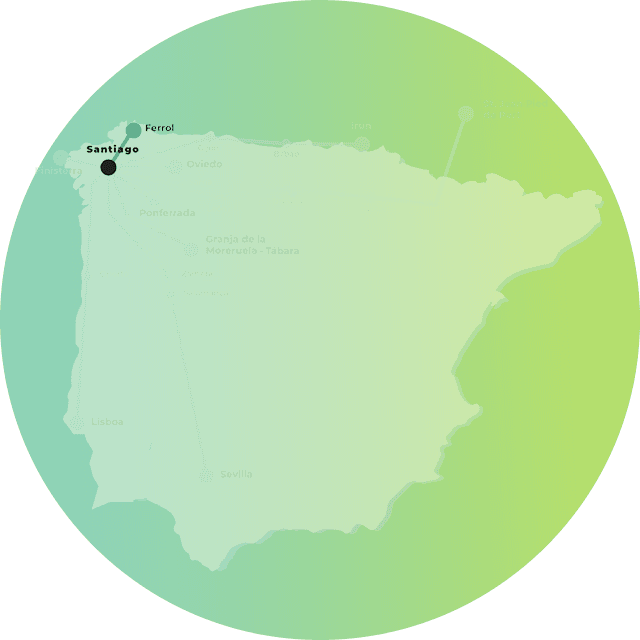
English Way
From Ferrol to Santiago de Compostela. Delve into the culture of villages of great military, naval and historical importance. 5 Etapas | 125 km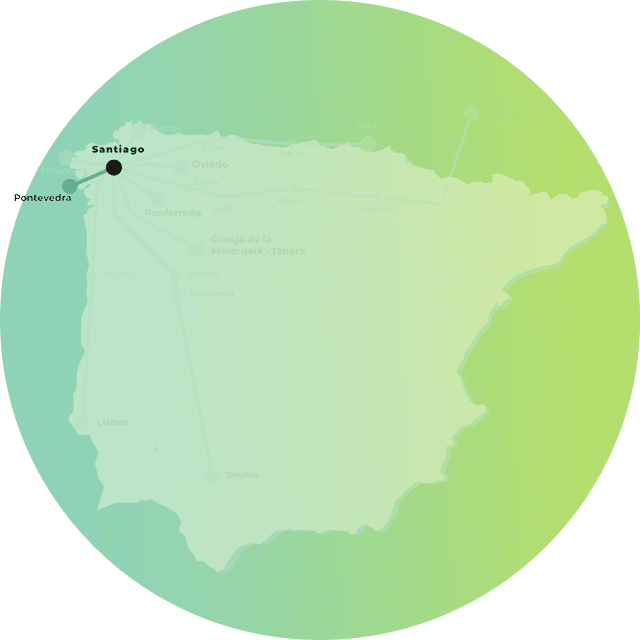
Father Sarmiento Way
The Father Sarmiento Way links Pontevedra to Santiago de Compostela, offering a scenic journey through beautiful landscapes. 6 stages | 142 km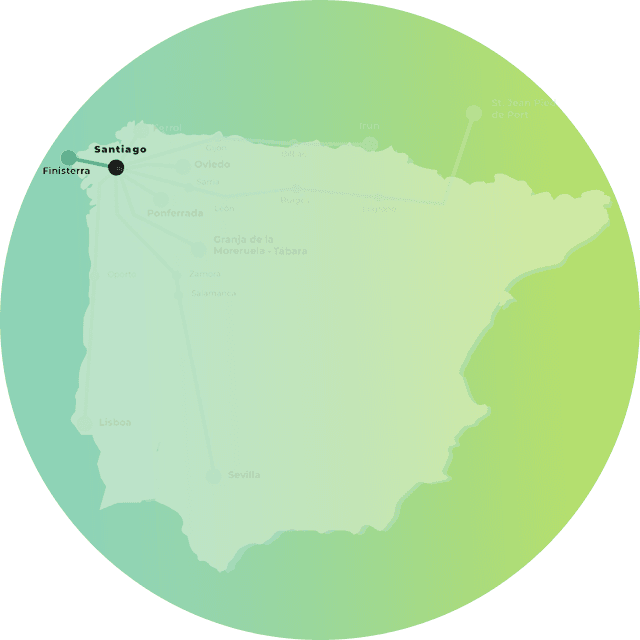
Finisterre and Muxía Way
From Santiago de Compostela to Muxía. A mystical and spiritual journey to the ends of the Earth 5 stages | 120 km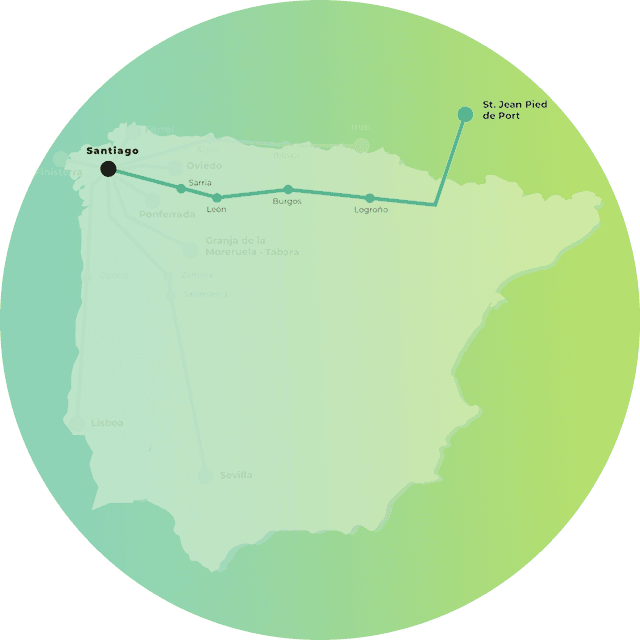
French Way
From Saint-Jean-Pied-de-Port to Santiago, trace Charlemagne’s path through the Pyrenees and trek 800 km on the French Way. 33 stages | 768 km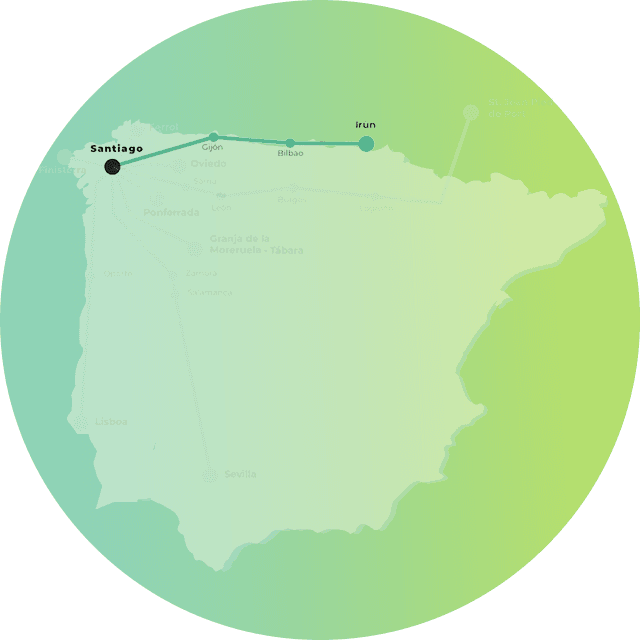
Northern Way
From Santiago de Compostela to Muxía. An unforgettable experience with breathtaking scenery 34 Stages | 820 km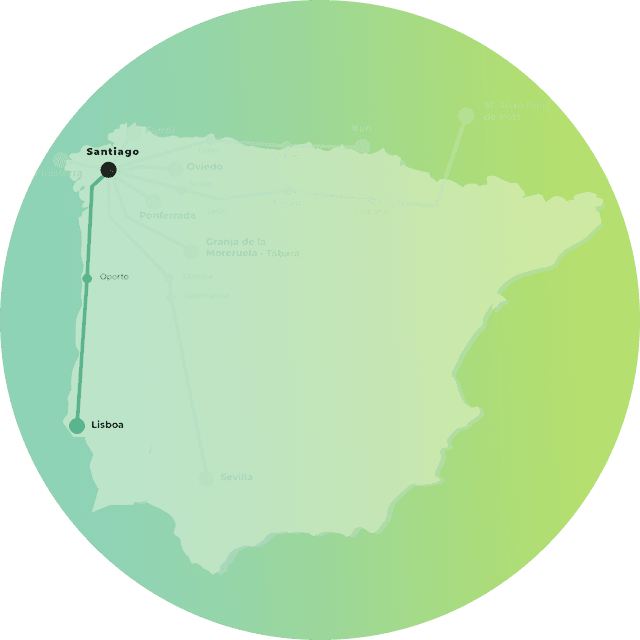
Portuguese Way
Starts in Lisbon and leads to Santiago de Compostela, offering a scenic journey through charming towns, coastal views, and culture. 27 stages | 620 km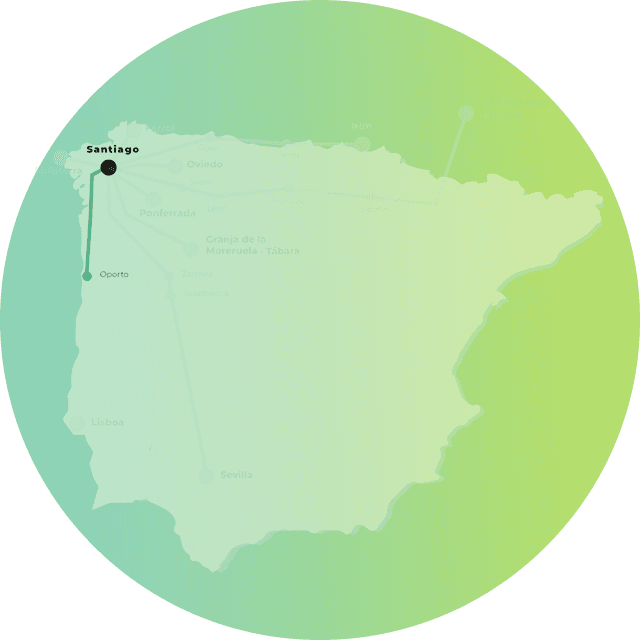
Portuguese Way along the coast
From Oporto to Santiago de Compostela. Total 194 km - 8 stages 8 Stages | 194 km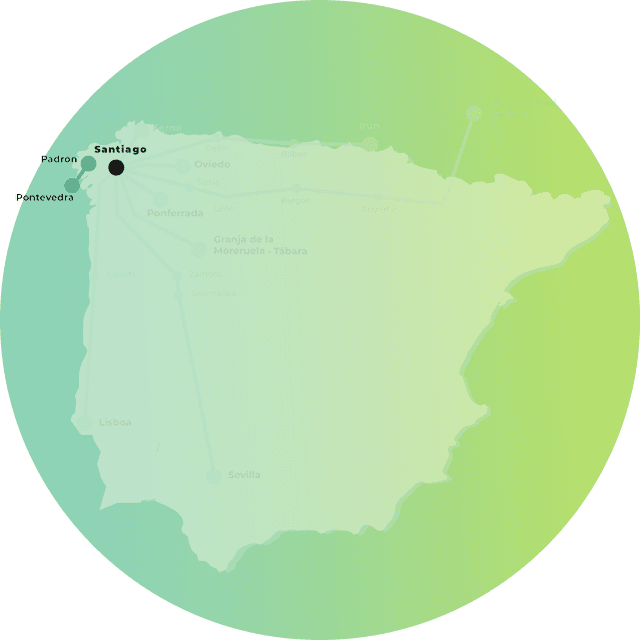
Portuguese Way: spiritual variant
From Pontevedra to Padrón. Total 81 km - 3 stages 3 stages | 81 km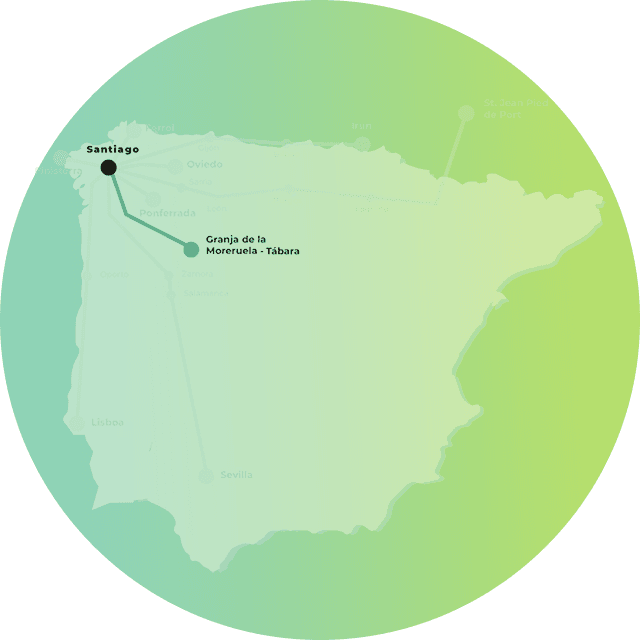
Sanabrian Way
From Granja de Moreruela to Santiago de Compostela. Total 365 km - 13 stages 13 stages | 365 km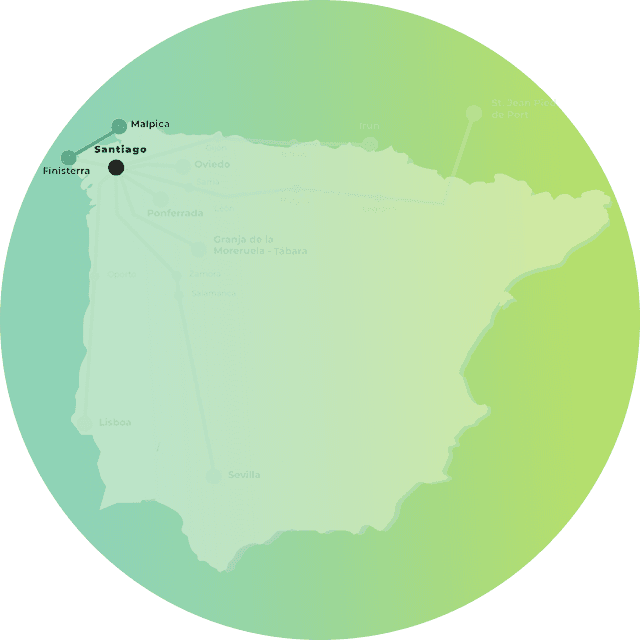
Way of the Lighthouses
From Malpica to Finisterre. A 200-kilometer journey along the coast and through the wildest of nature 8 stages | 195 km